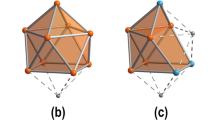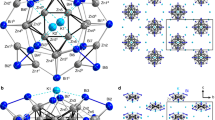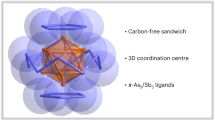Abstract
Heterometallic clusters are important in catalysis and small-molecule activation because of the multimetallic synergistic effects from different metals. However, multimetallic species that contain uranium–metal bonds remain very scarce due to the difficulties in their synthesis. Here we present a straightforward strategy to construct a series of heterometallic clusters with multiple uranium–metal bonds. These complexes were created by facile reactions of a uranium precursor with Ni(COD)2 (COD, cyclooctadiene). The multimetallic clusters’ cores are supported by a heptadentate N4P3 scaffold. Theoretical investigations indicate the formation of uranium–nickel bonds in a U2Ni2 and a U2Ni3 species, but also show that they exhibit a uranium–uranium interaction; thus, the electronic configuration of uranium in these species is U(iii)-5f26d1. This study provides further understanding of the bonding between f-block elements and transition metals, which may allow the construction of d–f heterometallic clusters and the investigation of their potential applications.
This is a preview of subscription content, access via your institution
Access options
Access Nature and 54 other Nature Portfolio journals
Get Nature+, our best-value online-access subscription
$29.99 / 30 days
cancel any time
Subscribe to this journal
Receive 12 print issues and online access
$259.00 per year
only $21.58 per issue
Buy this article
- Purchase on Springer Link
- Instant access to full article PDF
Prices may be subject to local taxes which are calculated during checkout



Similar content being viewed by others
Data availability
Crystal data of 1, 2, 3-U2Ni2Cl2, 4-U2Ni2 and 5-U2Ni3 have been deposited at the Cambridge Crystallographic Data Centre (CCDC) under reference numbers CCDC-1842367 (1), 1842368 (2), 1843093 (3-U2Ni2Cl2), 1843092 (4-U2Ni2) and 1842369 (5-U2Ni3). These data can be obtained free of charge from The Cambridge Crystallographic Data Centre (www.ccdc.cam.ac.uk/data_request/cif). All other data supporting the findings of this study are available within the article and its Supplementary Information, or from the corresponding author upon reasonable request.
References
Adams, R. D. & Cotton, F. A. Catalysis by Di- and Polynuclear Metal Cluster Complexes (Wiley-VCH, Weinheim, 1998).
Liddle, S. T. Molecular Metal–Metal Bonds: Compounds, Synthesis, Properties (Wiley-VCH, Weinheim, 2015).
Hill, M. S., Hitchcock, P. B. & Pongtavornpinyo, R. A linear homocatenated compound containing six indium centers. Science 311, 1904–1907 (2006).
Butovskii, M. V. et al. Molecules containing rare-earth atoms solely bonded by transition metals. Nat. Chem. 2, 741–744 (2010).
Shima, T. et al. Dinitrogen cleavage and hydrogenation by a trinuclear titanium polyhydride complex. Science 340, 1549–1552 (2013).
Hu, S., Shima, T. & Hou, Z. Carbon–carbon bond cleavage and rearrangement of benzene by a trinuclear titanium hydride. Nature 512, 413–415 (2014).
McWilliams, S. F. & Holland, P. L. Dinitrogen binding and cleavage by multinuclear iron complexes. Acc. Chem. Res. 48, 2059–2065 (2015).
MacKay, B. A. & Fryzuk, M. D. Dinitrogen coordination chemistry: on the biomimetic borderlands. Chem. Rev. 104, 385–401 (2004).
MacLeod, K. C. & Holland, P. L. Recent developments in the homogeneous reduction of dinitrogen by molybdenum and iron. Nat. Chem. 5, 559–565 (2013).
Gagliardi, L. & Roos, B. O. Quantum chemical calculations show that the uranium molecule U2 has a quintuple bond. Nature 433, 848–851 (2005).
Liddle, S. T. & Mills, D. P. Metal–metal bonds in f-element chemistry. Dalton Trans. 5592–5605 (2009).
Chi, C. et al. Preparation and characterization of uranium–iron triple‐bonded UFe(CO)3 − and OUFe(CO)3 − complexes. Angew. Chem. Int. Ed. 56, 6932–6936 (2017).
Fox, A. R., Bart, S. C., Meyer, K. & Cummins, C. C. Towards uranium catalysts. Nature 455, 341–349 (2008).
Thomson, R. K. et al. Uranium azide photolysis results in C–H bond activation and provides evidence for a terminal uranium nitride. Nat. Chem. 2, 723–729 (2010).
Arnold, P. L. et al. Strongly coupled binuclear uranium–oxo complexes from uranyl oxo rearrangement and reductive silylation. Nat. Chem. 4, 221–227 (2012).
Arnold, P. L., Mansell, S. M., Maron, L. & McKay, D. Spontaneous reduction and C–H borylation of arenes mediated by uranium(iii) disproportionation. Nat. Chem. 4, 668–674 (2012).
Halter, D. P., Heinemann, F. W., Bachmann, J. & Meyer, K. Uranium-mediated electrocatalytic dihydrogen production from water. Nature 530, 317–321 (2016).
Zhang, L., Zhang, C., Hou, G., Zi, G. & Walter, M. D. Small-molecule activation mediated by a uranium bipyridyl metallocene. Organometallics 36, 1179–1187 (2017).
Edelmann, F. T. Lanthanides and actinides: annual survey of their organometallic chemistry covering the year 2016. Coord. Chem. Rev. 338, 27–140 (2017).
Falcone, M., Chatelain, L., Scopelliti, R., Živković, I. & Mazzanti, M. Nitrogen reduction and functionalization by a multimetallic uranium nitride complex. Nature 547, 332–335 (2017).
Arnold, P. L. & Turner, Z. R. Carbon oxygenate transformations by actinide compounds and catalysts. Nat. Rev. Chem. 1, 0002 (2017).
Halter, D. P., Heinemann, F. W., Maron, L. & Meyer, K. The role of uranium–arene bonding in H2O reduction catalysis. Nat. Chem. 10, 259–267 (2018).
Sternal, R. S. & Marks, T. J. Actinide-to-transition metal bonds. Synthesis, characterization, and properties of metal–metal bonded systems having the tris(cyclopentadienyl) actinide fragment. Organometallics 6, 2621–2623 (1987).
Bucaille, A., Le Borgne, T., Ephritikhine, M. & Daran, J. C. Synthesis and X-ray crystal structure of a urana[1]ferrocenophane, the first tris(1,1′-ferrocenylene) metal compound. Organometallics 19, 4912–4914 (2000).
Monreal, M. J. & Diaconescu, P. L. A weak interaction between iron and uranium in uranium alkyl complexes supported by ferrocene diamide ligands. Organometallics 27, 1702–1706 (2008).
Gardner, B. M., McMaster, J., Lewis, W. & Liddle, S. T. Synthesis and structure of [{N(CH2CH2NSiMe3)3}URe(η5-C5H5)2]: a heterobimetallic complex with an unsupported uranium–rhenium bond. Chem. Commun. 2851–2853 (2009).
Patel, D. et al. A formal high oxidation state inverse‐sandwich diuranium complex: a new route to f‐block‐metal bonds. Angew. Chem. Int. Ed. 50, 10388–10392 (2011).
Fortier, S., Walensky, J. R., Wu, G. & Hayton, T. W. High-valent uranium alkyls: evidence for the formation of Uvi(CH2SiMe3)6. J. Am. Chem. Soc. 133, 11732–11743 (2011).
Gardner, B. M. et al. The nature of unsupported uranium–ruthenium bonds: a combined experimental and theoretical study. Chem. Eur. J. 17, 11266–11273 (2011).
Gardner, B. M. et al. An unsupported uranium–rhenium complex prepared by alkane elimination. Chem. Eur. J. 17, 6909–6912 (2011).
Patel, D. et al. Structural and theoretical insights into the perturbation of uranium–rhenium bonds by dative Lewis base ancillary ligands. Chem. Commun. 47, 295–297 (2011).
Napoline, J. W. et al. Tris(phosphinoamide)-supported uranium–cobalt heterobimetallic complexes featuring Co→U dative interactions. Inorg. Chem. 52, 12170–12177 (2013).
Ward, A. L., Lukens, W. W., Lu, C. C. & Arnold, J. Photochemical route to actinide–transition metal bonds: synthesis, characterization and reactivity of a series of thorium and uranium heterobimetallic complexes. J. Am. Chem. Soc. 136, 3647–3654 (2014).
Senchyk, G. A. et al. Hybrid uranyl–vanadium nano-wheels. Chem. Commun. 51, 10134–10137 (2015).
Hlina, J. A., Pankhurst, J. R., Kaltsoyannis, N. & Arnold, P. L. Metal–metal bonding in uranium–group 10 complexes. J. Am. Chem. Soc. 138, 3333–3345 (2016).
Hlina, J. A., Wells, J. A., Pankhurst, J. R., Love, J. B. & Arnold, P. L. Uranium–rhodium bonding in heterometallic complexes. Dalton. Trans. 46, 5540–5545 (2017).
Fortier, S. et al. An N-tethered uranium (iii) arene complex and the synthesis of an unsupported U–Fe bond. Organometallics 36, 4591–4599 (2017).
Lu, E., Wooles, A., Gregson, M., Cobb, P. & Liddle, S. T. A very short uranium(iv)–rhodium(i) bond with net double‐dative bonding character. Angew. Chem. Int. Ed. 57, 6587–6591 (2018).
Greenwood, B. P., Rowe, G. T., Chen, C. H., Foxman, B. M. & Thomas, C. M. Metal−metal multiple bonds in early/late heterobimetallics support unusual trigonal monopyramidal geometries at both Zr and Co. J. Am. Chem. Soc. 132, 44–45 (2010).
Culcu, G. et al. Heterobimetallic complexes comprised of Nb and Fe: isolation of a coordinatively unsaturated Nbiii/Fe0 bimetallic complex featuring a Nb≡Fe triple bond. J. Am. Chem. Soc. 139, 9627–9636 (2017).
Rudd, P. A. et al. Metal–alane adducts with zero-valent nickel, cobalt, and iron. J. Am. Chem. Soc. 133, 20724–20727 (2011).
Eisenhart, R. J., Clouston, L. J. & Lu, C. C. Configuring bonds between first-row transition metals. Acc. Chem. Res. 48, 2885–2894 (2015).
Sgro, M. J. & Stephan, D. W. Frustrated Lewis pair inspired carbon dioxide reduction by a ruthenium tris(aminophosphine) complex. Angew. Chem. Int. Ed. 51, 11343–11345 (2012).
Gardner, B. M. & Liddle, S. T. Uranium triamidoamine chemistry. Chem. Commun. 51, 10589–10607 (2015).
Pyykkö, P. & Atsumi, M. Molecular single‐bond covalent radii for elements 1–118. Chem. Eur. J. 15, 186–197 (2009).
Ritchey, J. M. et al. An organothorium–nickel phosphido complex with a short Th–Ni distance. The structure of Th(η5-C5Me5)2(μ-PPh2)2Ni(CO)2. J. Am. Chem. Soc. 107, 501–503 (1985).
Hay, P. J., Ryan, R. R., Salazar, K. V., Wrobleski, D. A. & Sattelberger, A. P. Synthesis and X-ray structure of (C5Me5)2Th(μ-PPh2)2Pt(PMe3): a complex with a thorium–platinum bond. J. Am. Chem. Soc. 108, 313–315 (1986).
Rinehart, J. D., Harris, T. D., Kozimor, S. A., Bartlett, B. M. & Long, J. R. Magnetic exchange coupling in actinide-containing molecules. Inorg. Chem. 48, 3382–3395 (2009).
Mills, D. P. et al. A delocalized arene-bridged diuranium single-molecule magnet. Nat. Chem. 3, 454–460 (2011).
Kindra, D. R. & Evans, W. J. Magnetic susceptibility of uranium complexes. Chem. Rev. 114, 8865–8882 (2014).
Acknowledgements
This research was supported by the National Natural Science Foundation of China (grant no. 21772088), the Natural Science Foundation of Jiangsu Province (grant no. BK20170635), the Fundamental Research Funds for the Central Universities, the program of Jiangsu Specially-Appointed Professor and the Young Elite Scientist Sponsorship Program of the China Association of Science and Technology. The authors thank Y. Song (Nanjing University) and S. Jiang (Peking University) for useful discussion.
Author information
Authors and Affiliations
Contributions
C.Z. conceived this project. G.F. performed the synthesis experiments. M.Z. solved all of the X-ray structures. D.S. performed the SQUID experiments. C.Z. and G.F. analysed the experimental data. L.M. conducted the theoretical computations and analysed the results. C.Z. and L.M. drafted the paper with support from G.F., X.W. and S.W. All the authors discussed the results and contributed to the preparation of the final manuscript.
Corresponding authors
Ethics declarations
Competing interests
The authors declare no competing interests.
Additional information
Publisher’s note: Springer Nature remains neutral with regard to jurisdictional claims in published maps and institutional affiliations.
Supplementary information
Supplementary Information
Experimental procedures; Supplementary figures; X-ray crystallographic analysis; theoretical calculations; Supplementary references
Crystallographic data
CIF for compound 1; CCDC reference: 1842367
Crystallographic data
CIF for compound 2; CCDC reference: 1842368
Crystallographic data
CIF for compound 3-U2Ni2Cl2; CCDC reference: 1843093
Crystallographic data
CIF for compound 4-U2Ni2; CCDC reference: 1843092
Crystallographic data
CIF for compound 5-U2Ni3; CCDC reference: 1842369
Rights and permissions
About this article
Cite this article
Feng, G., Zhang, M., Shao, D. et al. Transition-metal-bridged bimetallic clusters with multiple uranium–metal bonds. Nature Chem 11, 248–253 (2019). https://doi.org/10.1038/s41557-018-0195-4
Received:
Accepted:
Published:
Issue Date:
DOI: https://doi.org/10.1038/s41557-018-0195-4
This article is cited by
-
Thorium(iv)–antimony complexes exhibiting single, double, and triple polar covalent metal–metal bonds
Nature Chemistry (2024)
-
Bimetallic cooperation across the periodic table
Nature Reviews Chemistry (2020)




